The nature of waves - physics explained
Waves have always been one of my favorite physics topics and so it is only natural for them to take their place in my physics explained series. I have already said, in one of my previous posts, how I want to explain sound to you but before I do, vibration and waves have to come first. We already know the basics of vibration and now it is the time to address the waves. Before we start, here is a list of previously published posts in the series, be sure to check the one about vibration to remind yourself of everything we have covered so far.
VIBRATION
DOPPLER EFFECT
COLD BOILING WATER
HOW DO WE SEE COLORS
LEARN ABOUT RAINBOWS
EVERYTHING IS MAGNETIC!
NEWTON'S LAWS OF MOTION
DIFFERENCE BETWEEN HEAT AND TEMPERATURE
CALCULATE THE SPEED OF LIGHT USING CHOCOLATE
There is usually no previous knowledge required to follow along my posts but this one will be the first exception. Since this is the second step in getting to sound, to be able to really understand waves, you have to have some knowledge about vibration and periodic motion so be sure to visit my post about vibration if you forgot about it. If you remember, good for you! Carry on and learn everything about waves. Let's go!
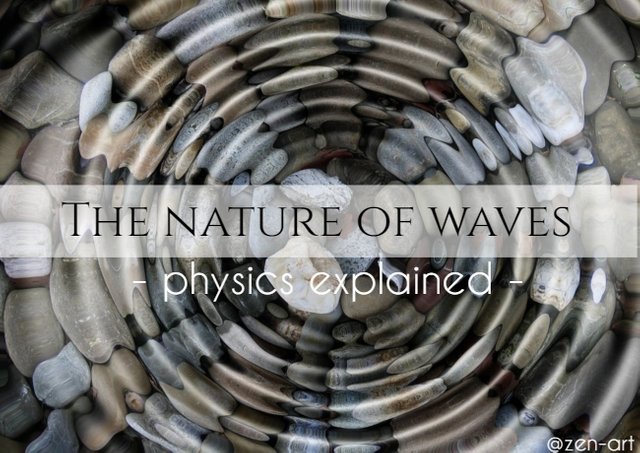
Waves are all around us and not only are they responsible for us hearing music, heating our food and enjoy water sports, there would be no life without them for the Sun's light that we so often take for granted, is also a wave, an electromagnetic one. Ever since ancient Greeks, people were interested in waves and it was Pythagoras in 550 BCE who observed how vibrating strings produced sound. Galileo Galilei, Robert Boyle, and Isaac Newton followed him with their own discoveries in that field but it wasn't until 18th century when Jean Le Rond d'Alembert derived the wave equation that cleared the area and made it possible for many future scientists to explain wave phenomena.


To put it simply, a wave is a traveling disturbance. It is a disturbance that propagates through a medium with a transfer of energy. Different waves have different mediums. We have mechanical waves where matter is the medium such as water waves, those on strings and sound waves. With electromagnetic waves, there is no material medium needed since electric and magnetic fields are vibrating and we also have gravitational waves which travel through the gravitational field.
Depending on the way how the waves travel, we have two fundamental types of waves; TRANSVERSE and LONGITUDINAL. We will focus more on the transverse waves in this post and leave the longitudinal ones for when we come to sound.
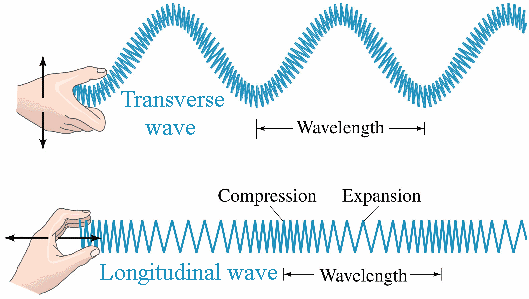
With LONGITUDINAL waves, the particles are disturbed in a direction parallel to the direction that the wave propagates and we have compressions and expansions of particles in a medium. TRANSVERSE waves, on the other hand, move in the direction perpendicular to the motion of particles so while the particles are vibrating up and down, the wave will move left or right. Remember what we have learned about vibration? Waves are related to it.
The medium is a collection of interacting particles
Those particles are influencing each other all the time and if you imagine a string where you move one particle up, the others will follow. The simplest way to visualize this is with a slinky. When the first coil in the slinky becomes disturbed, it will push or pull the second coil, the second will do the same to the third and we will be able to see a wave motion. Coils will be moving up and down but the wave will propagate left-right. With transverse waves, every particle of the medium is oscillating around a fixed position and the propagation of the wave is perpendicular to that oscillation.
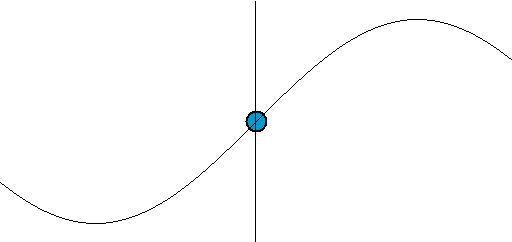
A wave does not move mass in the direction of propagation;
IT TRANSFERS ENERGY.
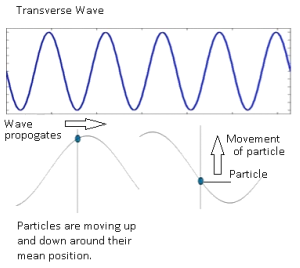
Those particles that are vibrating up and down and causing the particle next to them to vibrate too. They are not transferring mass to one another, they are not shrinking or growing. All that they are doing is transferring energy to one another, if they were not, the other particle would not move. There is no moving of mass in waves and they are considered to be energy transport phenomenon. Keeping that in mind, how energy is always transported in waves, are the stadium waves really waves? Nope, we call them waves because their motion resembles that from waves but since there is no transfer of energy, they are not waves.


We can describe waves with many things but the most important ones are frequency, wavelength, and amplitude. The amplitude (A) of the wave is the maximum displacement of a particle from its equilibrium position, we also call it the hight of the wave. The wavelength (λ) is the length of one cycle of the wave and can be seen anywhere in the wave, between two successive wave crests, troughs or any other two equivalent points on the wave. Since both amplitude and wavelength are measuring a distance, they are both in meters.
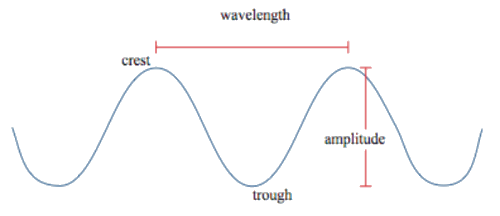
Another important thing we have to explain is the PERIOD. The wave period (T) is the time required for any point to complete one full cycle of its motion, from where it started to back where it started. It is measured in seconds and is related to frequency. We can always get one from the other since frequency is the number of wave cycles completed by any point along the wave in a certain time period and is measured in Hz.

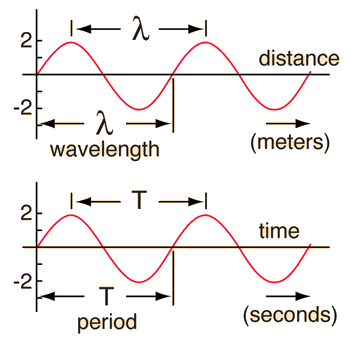
It is important to realize how depending on what we have on our axis, there are different things to be observed on the graph. If we put displacement in meters on the x-axis and the distance in meters on the y-axis then we can clearly see wavelength from one crest to another but if we put time on the y-axis then we have a period from one crest to another. Notice how the amplitude is on the x in both cases. We could put the velocity on the x-axis too but let's define it first. As in any other part of physics or life for that matter, velocity is always the distance passed in a certain amount of time. It is defined like that here too.

Wave speed tells us how fast the wave is traveling and it can either be shown using wavelength and period or wavelength and frequency. In both cases, speed is measured in meters per second. The only thing that is left to learn before moving on to the wave equation is the wave phase. It is an angular quantity and is measured in radians. We say that adjacent points which are separated by one complete cycle are in phase and those that are separated by half a cycle are out of phase. You can see how phase difference looks like at the image below.
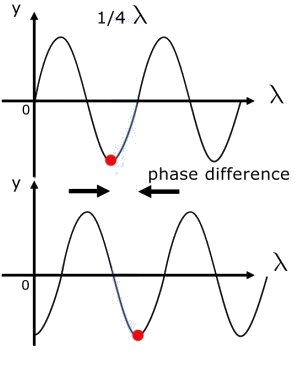


We have already covered so much, and yet, everything that was written so far can be considered an intro into waves. Now, the actual defining of the waves comes. Let's review what we have covered so far since we will need it all.
| Term | Description | Unit |
|---|---|---|
| wavelength | length of one cycle of the wave | meters |
| amplitude | maximum displacement from equilibrium position | meters |
| period | time to complete one full cycle | seconds |
| frequency | number of wave cycles in time | Hz |
| velocity | speed of wave | m/s |
| phase | position of a point in time | radian |
When describing waves mathematically, the most basic wave is the one-dimensional sine wave. We describe the amplitude u with the following equation:
u(x,t)=Asin(kx−ωt+ϕ)
x and t are space and time coordinates, A is the maximum amplitude, k is the wave number, ω is the angular frequency and the ϕ is the phase. We can write that in two ways, using sine or cosine and we have two common expressions for a traveling wave confined to one plane in space:

Those equations are the solutions for the main partial differential equation for one-dimensional wave that is given by:

The solution to the wave equation can be, of course, written in several ways. It depends on our choices for related parameters.
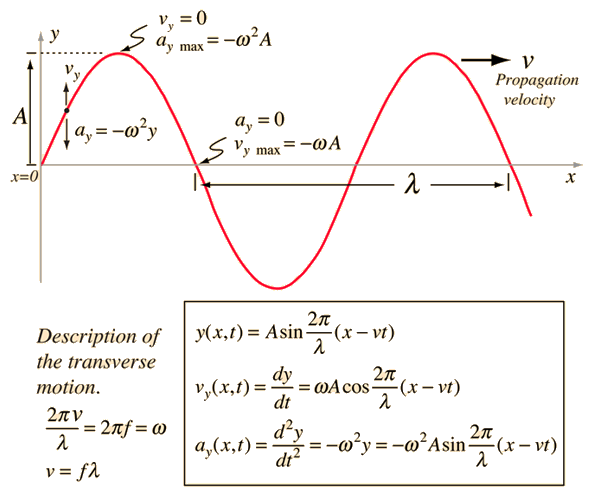


There you go. This is not everything about waves, these are the basics and not even all the basics, just the ones we need before finally moving on to sound. I am looking forward to it, are you? In this post we have covered the following:
- how waves are created and connected to the vibration
- difference between longitudinal and transverse waves
- descriptive elements: A, v, T, f, λ, ϕ
- wave function and equation
If you are interested in learning more (and I hope you are), check out these references:
Classical Wave Equations and Solutions
Waves from hyperphysics.phy
Waves from physicsclassroom
Waves from lumenlearning
The nature of waves from physics.info
Wave Equation from wolfram.com
Waves and wave motion from visionlearning
KEEP YOUR SMILE ON
RESPECT YOUR INNER GENIOUS!

If you are interested in something physics (or science in general) related, tell me and I would be happy to make a post about it and explained it. Promoting science and making it understandable gives me great joy, I would be happy to help you.

Image sources:
- cover image is from pixabay and is free for personal and commercial use, you can find it here
- wave clipart in my titles is from FREE CLIPART LIBRARY and can be found here
- transverse and longitudinal waves image is from thinglink.com and can be found here
- wave and particle image is from examfear.com and can be seenhere
- gif image of particle vibrating is from lumenlearning.com and can be foundhere
- phase difference photo is from levelphysicstutor.com and can be found here
- image with period and wavelength is from askiitians.com and is here
- amplitude and wavelength image is from wiki and is here here
- last image with equations and graph is from hyperphysics.phy here
- wave clipart in my titles is from FREE CLIPART LIBRARY and can be found here
- transverse and longitudinal waves image is from thinglink.com and can be found here
- wave and particle image is from examfear.com and can be seenhere
- gif image of particle vibrating is from lumenlearning.com and can be foundhere
- phase difference photo is from levelphysicstutor.com and can be found here
- image with period and wavelength is from askiitians.com and is here
- amplitude and wavelength image is from wiki and is here here
- last image with equations and graph is from hyperphysics.phy here
PROUD MEMBER OF:



@steemitbloggers

Brings me back to my high school days.
- Those extra-long Slinkys.
- Shallow square basins with a half inch of water.
Remember? That was a long time ago for me.Oh yeah, that really was a long time ago :)
That was quite a read. There is one thing that still puzzles me though, and that is how a particle can move in one place, while another particle far remote moves in synchronicity with it...
Particles are influencing each other all the time. One particle is affecting those next to it, that one is affecting the ones next to it and so on. As a result, we have many particles that move in a phase. Everything is, in a way, connected to everything else. If this troubles you, one particle being in two places at the same time will blow your mind :) Nope, not teleporting, ONE SINGLE particle can be at the two places at the same time just as electrons are not moving, they really are teleporting from one place to another and when we are describing their position, we are talking about probabilities to find them in a certain position in any given time. Quantum world is like falling through the rabbit hole and finding Alice on the other side lol, never boring :D
So sound moves in waves yet not through a vacuum; whereas light on the other hand can move through a vacuum and also moves in waves; so I guess they must be different types of vibration; which doesn't explain why a particle can be in two places at once
Nope, it does not explain that, hence the "down the rabbit hole" reference ;)
You did get that right, sound needs matter and light can travel through the vacuum. They are different types of waves. Why a particle "can" be in two places is one of those things that could get us a Nobel prize if we found the answer. Some things we still can only observe but not explain. There are many why questions that we still do not have answers to.
For all intents and purposes a void is a void if it is deemed empty of all measurable substances; but it is possible that there is no true void and that it is filled with a substance that is no substance and so can’t be detected or measured and that is why light travels in waves and particles both.
Sound won’t travel in a void because the particles are too small to carry the sound waves; but light, being a higher energy makes use of this invisible substance to travel along similar to the way sound uses the atmosphere to travel.
This has yet to be proved and so remains a theory and like Zen this can best be understood when you don’t say anything about it at all.
(Moriarty)
Very well written and informative article. I love to hear the sound of waves, I wonder if there is something in my past lives that I associate with lapping water? ;)
I will soon write about sound, I hope it will interesting enough for you. Thank you for your kind comment 💚
This is such a great post @zen-art!
I always relate them to energy, everything around us has its own vibrations of energy, still or vibrate they are all connected.
Everything vibrates, indeed! I am glad you enjoyed the post 💚
Thank you!
Really enjoying this series, you do a nice job of keeping everything approachable without sacrificing detail. I know from my own experience that that can be a challenge.
It can be challenging at times because there are people with absolutely no knowledge in science and there are those with scientific backgrounds. There is a thin line I have to walk to satisfy both groups. Posts need to be easy enough for anyone to read and understand and they have to be interesting enough for brainiacs to read and not find them boring or too simple. I try, sometimes I succeed and sometimes I fail :D
@zen-art I am right there with you on that fine line. I try to write for my audience, but it's just so diverse here that it is inevitable some posts will be over or under written.
Awesome post :D my sort of thing, I love how so many things in nature can be expressed through mathematical equations.
I often say that math is like a shovel to physicists. If you wanted to plant a flower in your backyard, you could dig the hole in the ground with your hands but you could also use a shovel as a tool to help you out. That is math, a helpful tool for to every scientific field. Thank you for your kind comment.
I remember learning a lot about waves in general and radio wave sin particulr in my training as a telecom Engineer, this wasa good refresher to read
I am glad this post reminded you of that and refreshed your memory, thank you for your kind comment 💚
@zen-art Always a pleasure to visit
What a great compilation of analysis and reference material! I wish steem had a better home for “evergreen” content like this, so I Iove your collection of links to your past posts!
Thank you! I am glad you enjoyed the reference links. There are great posts under @steemstem and @steemiteducation tag for you to check out, people are really writing about interesting things.
I found this passage intriguing:
And then you say that medium is a collection of interacting particles, and that waves transfer energy, not mass.
So light propagates through the vacuum of space. What collection of particles is transferring the energy? You said that waves don't move mass and photons don't have mass. Yet, the photons must be traveling through a medium, a collection of particles, in the vacuum of space...
Huh.
Photons have dual nature: sometimes they behave like particles, sometimes they behave like waves. Therefore, they indeed are "a collection of interacting particles", so you could say they are their own medium (in a way). Yes, I know, things get very strange at such small scales.
Since @vortac was so nice and answered your question there @digitalfirehose, I will not repeat what he said but since your question is interesting and valuable I will do a post about the particle-wave nature of photons in the future, hopefully by the end of this week, maybe even tomorrow, who knows. I have a philosophy theme on my menu today but I will do my best to explain the photons until this week ends. Thank you for your interesting question and for having an interest in this subject and thank you @vortac for being my helpful brainiac and stepping in with your wisdom💚
Thank you too, @zen-art. I look forward to reading more on this topic by your pen. :)
Well, there is the particle-wave duality to consider. But as the parent article suggests, a wave is a disturbance in a collection of particles, and the particles in the wave don't move with the wave, they transfer the energy of the wave.
This is why I ask the question about the medium of light. Light travels in a medium. Light is a disturbance of the particles that act as the medium of the light. The photons do not appear to me to be the medium since photons travel, but they do transmit energy.
It's an interesting conundrum.
This is awesome! I'm amazed at how many smart people are on Steemit. This is a really cool lesson on waves. A good refresher. lol
Awww, thank you. I am glad you enjoyed the lesson 💚